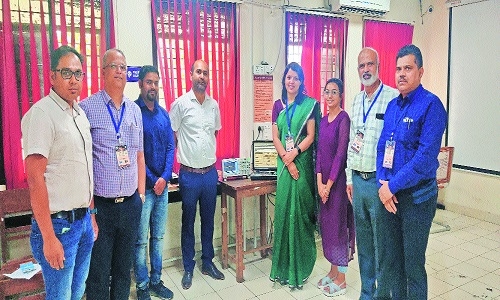ISRO-VNIT working to increase Internet speed
| Date :27-Apr-2023 |

Staff Reporter
When one uses the Internet on cellphone or laptop or any such devices, one gets annoyed over the low speed, especially while downloading heavy files. Nowadays, the issue has become a regular feature with any data service provider/network. This can be better illustrated with an example of increased traffic on the road. Similarly, the issue arises when there are too many data users at a given time. The Visvesvaraya National Institute of Technology (VNIT) has submitted a project which has a solution to clear data traffic and increase the speed of the Internet, to Indian Space Research Organisation (ISRO). The Space Applications Centre at Ahmedabad, a unit of ISRO has approved the project.
During the coronavirus pandemic, most of the workload across the globe was on online. The inclusion of virtual mode in day-to-day life due to COVID, resulted in a massive surge in data traffic in entire world. To address the increased data traffic, there is a need for high-speed and low-power solutions over current data center interconnects (DCIs). The Indian Space Research Organisation (ISRO) has sanctioned a research project to the Department of Electronics and Communication Engineering, VNIT.
The team of researchers under Dr Anamika Singh, Assistant Professor at the Department, who is also Principal Investigator, will work for the development of the transmitter and receiver chips using silicon photonics technology.
Dr Anamika Singh, who is working as an Assistant Professor, said, “We will develop a self-coherent silicon photonic integrated circuit (IC) with polarisation plexed carrier which supports higher order modulation such as M-ary QAM (Quadrature Amplitude Modulation) and can handle increasing higher data traffic demands with simple Implementation than coherent links. This project will run for three years and is coordinated by the Space Applications Centre (SAC), Ahmedabad.” The title of the project is Photonic Integrated Circuit (PIC) based Tx (Transmitter) and Rx (Receiver) with multiplexed optical channels employing polarisation modulation and homodyne/heterodyne detection. The integration of optical components and functions into a large scale PIC shows significant benefits when it is integrated into an optical communication system. It enables significant power, space and cost savings, new functionality, enough for increasing transmission capacity of communication systems. Once this is applied, it will not only save the cost but also the time consumed unnecessarily too. The team responsible for executing this project include Dr Prabhat Sharma, the co-investigator; Chandresh Dhote and Shelma Sajan, both scholars working in the research group of Dr Singh. Dr Anamika informed to ‘The Hitavada’ that her research group had been actively working for the development of optical biosensors for biomedical applications and intelligent surfaces for wireless communication systems. The Director of VNIT Prof. Pramod Padole and Prof Avinash Keskar, HoD, supported the team. Prof Padole said, the researchers would successfully implement the high speed communication chip which would pave the way for high speed satellite communications, and contribute to the self-reliant India (Atmanirbhar Bharat). Prof. Ranjan Mallik, a distinguished professor from IIT Delhi, appreciated the efforts taken by the research group. He shared that this high-speed chip will be useful for 6G wireless communication systems specifically for applications which need ultra high reliability and very low latency.
